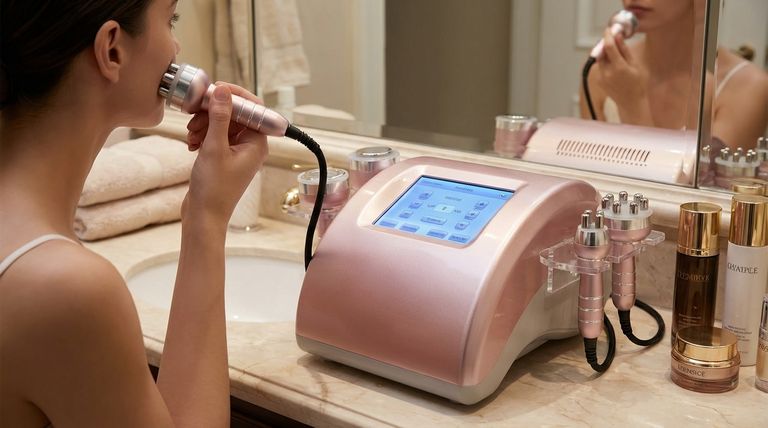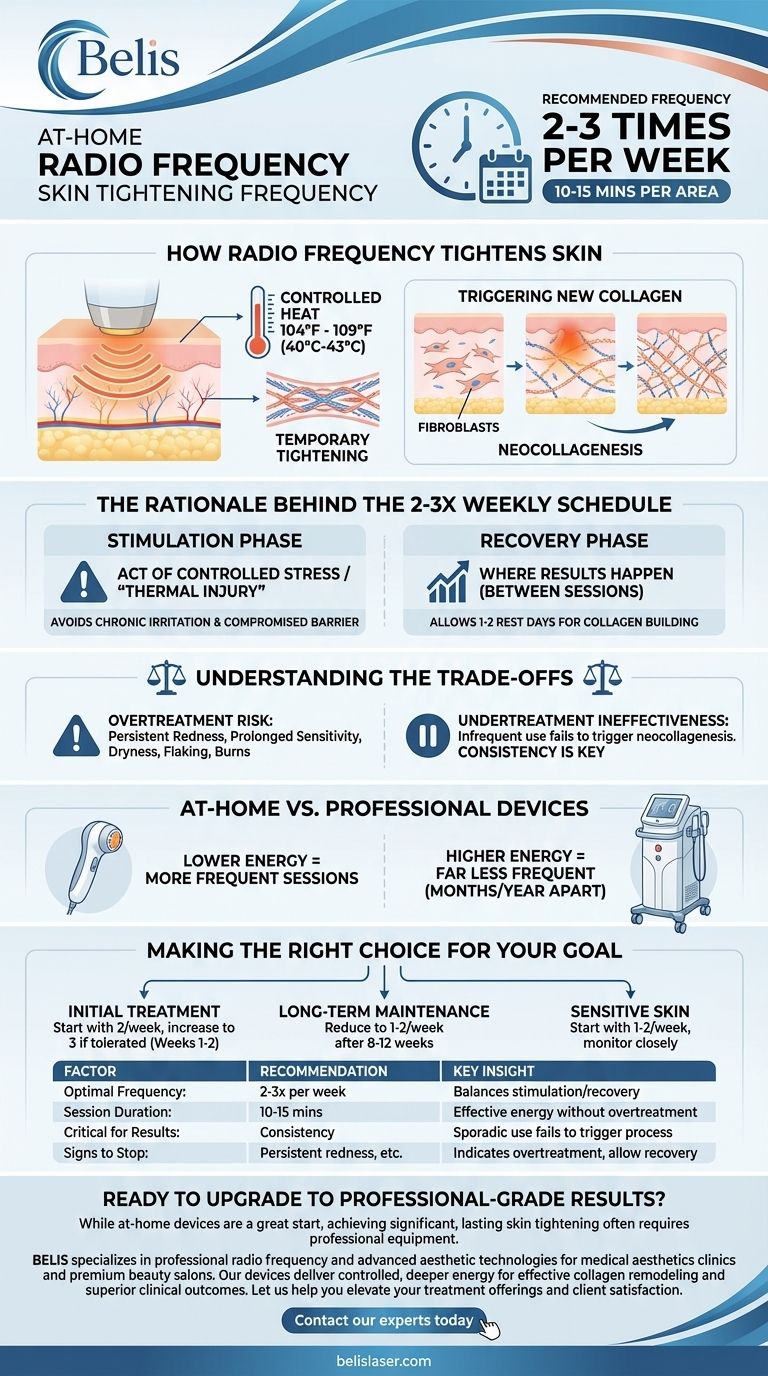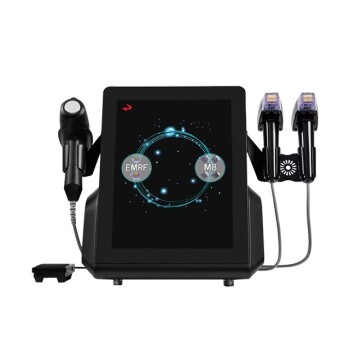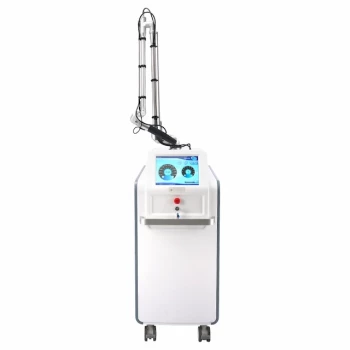For at-home radio frequency (RF) treatments, the generally recommended frequency is two to three times per week. Each session should last approximately 10 to 15 minutes per treatment area. This schedule is designed to consistently stimulate collagen production without over-stressing your skin's natural recovery processes.
The key to effective at-home RF is not intensity, but consistency. The goal is to apply just enough thermal energy to trigger a regenerative response, and then allow your skin the necessary time to heal and rebuild between sessions.

How Radio Frequency Actually Tightens Skin
To understand the correct frequency, you must first understand the mechanism. RF devices do not magically shrink skin; they create a controlled thermal effect deep within the dermis.
The Role of Controlled Heat
Radio frequency energy gently heats the dermal tissue to an optimal temperature, typically between 104°F and 109°F (40-43°C) for at-home devices.
This targeted heat achieves two distinct goals. First, it causes the existing, loosely organized collagen fibers in your skin to immediately contract, providing a temporary tightening effect.
Triggering New Collagen Production
More importantly, this thermal stress acts as a signal to the body. It stimulates specialized cells called fibroblasts, which are the "collagen factories" in your skin.
In response to the heat, these fibroblasts begin the process of neocollagenesis—the creation of new, strong, and organized collagen and elastin. This is the process that creates genuine, long-term improvements in skin firmness and texture.
The Rationale Behind the 2-3x Weekly Schedule
The recommended frequency is a direct reflection of your skin's biological cycle of stimulation and repair.
The 'Stimulation Phase': Why Not Every Day?
Treating your skin with RF is an act of controlled stress. You are intentionally creating a mild "thermal injury" to provoke a healing response.
Performing this daily would prevent the skin from ever moving past the initial inflammatory phase. This can lead to chronic irritation, a compromised skin barrier, and can actually inhibit the collagen-building process you're trying to encourage.
The 'Recovery Phase': Where the Results Happen
The most critical results from RF treatments occur between your sessions. This is the recovery phase when your stimulated fibroblasts are actively working to build new collagen networks.
Allowing for 1-2 rest days between treatments gives your skin the uninterrupted time it needs to execute this complex regenerative process. Skipping this recovery phase is like planting a seed and then digging it up every day to see if it's growing.
Understanding the Trade-offs and Critical Factors
Achieving results with at-home RF requires navigating a fine balance. Deviating from the optimal frequency has clear consequences.
The Risk of Overtreatment
Using your device too often or for too long can overwhelm your skin's ability to repair itself.
Signs of overtreatment include persistent redness, prolonged sensitivity, dryness, flaking, or in severe cases, surface burns. If you notice these signs, you must stop immediately and allow your skin to fully recover before resuming at a lower frequency.
The Ineffectiveness of Undertreatment
On the other hand, infrequent or inconsistent use will fail to produce results.
If the thermal stimulus is too weak or too sporadic, it won't be enough to reliably trigger neocollagenesis. This often leads to user frustration and the incorrect assumption that the device itself doesn't work. Consistency is non-negotiable.
At-Home vs. Professional Devices
It is crucial to understand that at-home RF devices operate at a much lower energy level than their professional counterparts used in a dermatologist's office.
This lower power is a safety feature, but it means that more frequent sessions are required to accumulate a sufficient biological effect. In-office treatments are far more powerful and are thus performed months or even a year apart.
Making the Right Choice for Your Goal
Your ideal schedule should be based on your skin's tolerance and your current treatment phase. Always start slow and follow the manufacturer's specific guidelines for your device.
- If your primary focus is starting an initial treatment cycle: Begin with 2 sessions per week for the first 1-2 weeks, increasing to 3 if your skin shows no signs of irritation.
- If your primary focus is long-term maintenance: After an initial 8-12 week treatment course, you can often reduce the frequency to 1-2 times per week to maintain results.
- If you have sensitive or reactive skin: Start with just 1-2 sessions per week, and be extra vigilant about monitoring for redness or irritation before increasing frequency.
Ultimately, your skin's response is the most important guide for a safe and effective treatment plan.
Summary Table:
| Factor | Recommendation | Key Insight |
|---|---|---|
| Optimal Frequency | 2-3 times per week | Balances collagen stimulation with skin recovery time. |
| Session Duration | 10-15 minutes per area | Ensures effective thermal energy delivery without overtreatment. |
| Critical for Results | Consistency | Sporadic use fails to trigger the neocollagenesis process effectively. |
| Signs to Stop | Persistent redness, sensitivity, dryness | Indicates overtreatment; allow skin to fully recover before resuming. |
Ready to upgrade to professional-grade results?
While at-home devices are a great start, achieving significant, lasting skin tightening often requires the power and precision of professional medical aesthetic equipment.
BELIS specializes in professional radio frequency and other advanced aesthetic technologies for medical aesthetics clinics and premium beauty salons. Our devices deliver controlled, deeper energy for more effective collagen remodeling and superior clinical outcomes.
Let us help you elevate your treatment offerings and client satisfaction. Contact our experts today to explore our range of professional solutions and discover the right technology for your business goals.
Visual Guide

Related Products
- Ultrasonic Cavitation Radiofrecuency Machine for Body Slimming
- Cryolipolysis Fat Freezing Machine and Ultrasonic Cavitation Device
- 4D 12D HIFU Machine Device for Skin Tightening and Lifting
- IPL SHR+Radio frecuency machine
- Hydrofacial Machine with Facial Skin Analyzer and Skin Tester
People Also Ask
- Where does fat go after cavitation? Understand the Journey from Cell to Elimination
- How many RF sessions do you need to see results? Achieve firmer, tighter skin with a personalized plan.
- When should you not use a cavitation machine? Critical Safety Guidelines for Aesthetic Treatments
- What does a cavitation machine do for your body? Sculpt Your Contours Without Surgery
- What are the restrictions for cavitation? Ensure Your Safety and Treatment Success



















